
![]()
 |
| A course being held inside the Building Science Laboratory. |
|---|
Duct Leakage and Unbalanced Airflows
Energy usage, comfort, indoor air quality and even building durability are affected by airflows. Management of air movement in buildings can mean the difference between success and failure.
HVAC Interactions
The Heating, Ventilation, and Air Conditioning (HVAC) system is a very dynamic piece in the building system. This system is responsible for the comfort of the occupants by controlling and maintaining temperature, relative humidity and ventilation needs. Pressure differences push/pull airflow through the building; forces that interact with the air barriers and pathways.
Ventilation Impacts on Energy and Humidity
Ventilation is needed for good indoor air quality. However, new ventilation requirements have created new problems by increasing latent cooling loads and indoor humidity. How can we meet ventilation requirements while controlling humidity? How can this be done most cost effectively?
Indoor Air Quality
Understanding uncontrolled air flows and pressure differentials is key to achieving high-performance buildings – including reduced allergy-related illnesses and workplace absenteeism. This laboratory facility will allow exploration of contaminant transport and generation, and how to create more productive indoor environments while minimizing toxins and allergens.
Dehumidification Technologies
It’s not the heat, it’s the humidity! Standard cooling systems remove moisture, but are normally controlled on temperature alone. How can we optimize the selection and control of equipment to meet various cooling and dehumidification loads? And when the standard equipment and optimized controls are not enough, what are the most cost-effective strategies and options for maintaining year-around humidity control?
Computer Modeling Validation
FSEC’s capabilities are internationally recognized. Careful validation within a controlled environment will help to further evolve various computer modeling software. Two identical buildings will provide the ability to vary a single parameter, while maintaining a control.
Building Systems Interactions
A building is a complex collection of components, assemblies and elements that are forged into a system. The interactions determine the health and safety, building durability, comfort and affordability of the building.
Additional Information
Download our Building Science Laboratory promotional flier. [162k pdf]
